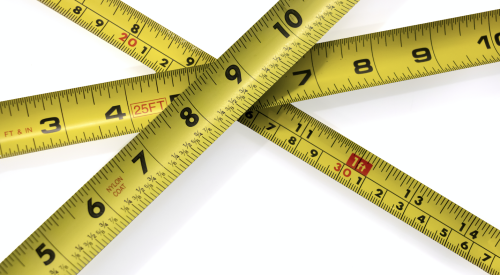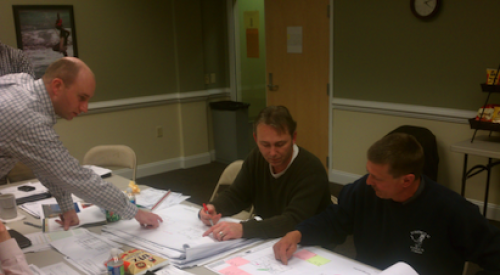Last month I introduced the notion of fallacies in home building—those beliefs we may be completely committed to yet which are errant and lead us astray. Such fallacies put up roadblocks to solving problems from the simple to the highly complex. Importantly, these are not mere errors of fact, which are usually relatively easy to correct. These are errors in reason or logic, often based on underlying ideology. And these errors are typically quite personal—the product of our own brains—and as such can be difficult to resolve. For evidence, simply watch 20 minutes of one of the ongoing presidential debates from either party, which I suggest we title, “Reason Takes a Holiday.”
Michael LaBossiere, in his book 76 Fallacies, gives an exhaustive and disturbing account of all 76 ways in which we are capable of fooling ourselves. Some macro, some micro, but all easily identified in our personal experiences and, taken as a whole, quite sobering. My reaction upon finishing the book was, “We haven’t got a prayer.” There are just too many ways to muck up any attempt to draw the right inference or conclusion because that requires carefully considered reason and intelligent thought.
So, after clearing my head by losing myself in more enjoyable things on the Internet such as vintage airplanes, ski area snow reports, and what TV celebrities from the ’70s look like today, I forced myself back to creating my list of fallacies encountered in our industry over the years.
As I often do, I sent my preliminary list to our four TrueNorth colleagues around the country as well as to a few favorite architects and engineers who help us on our Lean implementation processes. The list below is in no way exhaustive. I had to whittle it down from about 25 items gleaned from my list and those contributed by the FOTN (friends of TrueNorth). But here are the 12 fallacies that we have most often encountered in our combined 200-plus years working with more than 200 builders.
1. The fallacy of the calendar
If you plot the closing dates of the production builders in America, you’ll find that more than 90 percent follow a similar pattern. Closings are heavily back-end loaded toward the end of the month, quarter, and year. It’s not unusual to see a pattern such as:
Q1: 15 percent of closings
Q2: 20 percent of closings
Q3: 25 percent of closings
Q4: 40 percent of closings
I’ve even seen it as bad as 40 percent of closings in the last month of the year. When you challenge builders on this they typically spin a story about buying and/or building “seasons.” Customers naturally want to buy in the spring and summer, for example, so of course inflated fourth-quarter closing schedules are expected. Yet we know this is wrong. You can easily verify that by looking at builders that have non-calendar fiscal years. I’ve personally worked with builders that have their year-end in May, June, September, or October, and guess what? Their patterns are identical to those builders whose year ends Dec. 31. The year-end jam is nothing more than a self-fulfilling prophesy driven by finance and financial incentives, which has morphed into a cultural norm. We won’t cover the negative consequences that result, but they’re legion—all based on a fallacy.
2. Trade labor is a commodity
This makes as much sense as saying NFL quarterbacks are a commodity and can be quickly swapped with no consequences. If a builder owned a sports team, he’d never accept that for his team, would he? Just think back to Super Bowl XLI, Bears vs. Colts. Would Colts owner Bob Irsay for one moment entertain an offer from Bears’ CEO George Halas Jr. to trade QB Rex Grossman for Peyton Manning, even if he could have Rex for one-tenth the price? Absurd, right? Yet builders routinely change out trades and suppliers for a “nickel a square” as if a framer is a framer is a framer or all roofers are the same. If you still don’t believe me, ask any field superintendent. They know. They deal with the consequences every day.
3. The trade shortage is killing me
Yes, many trades left the industry during the downturn, and now business is up and we have a genuine shortage in the availability of trades. That’s true for the industry. The fallacy is that it must also be true for you. If you’re no different from and operate no better than anyone else, that is the case. Yet there are builders in severely trade-constrained markets that have no such shortage. In fact, the specific things they do to attract and keep trades create a distinct competitive advantage. Trade shortage as a strength? Check your reaction right there. Fallacies are powerful, aren’t they?
4. Low Bid = Low Cost
The only thing that buying on low bid price alone guarantees is that you’ll never operate under Lowest Total Cost … and that’s the only thing that matters. There is no builder on earth that hasn’t been burned by low bids, and the reality is that most builders don’t know how to measure total cost. Learn it, use it, make better decisions. The old adage “You get what you pay for” turns out to be true, but if—and only if—you are measuring total cost.
5. Building by the IRC saves money
Anyone who has employed a good, cost-conscious engineer (one who doesn’t carry the CYA designation after his or her name), then told that engineer to have at it, no mercy, discovers that a plan specifically engineered to the International Building Code—rather than the one-size-fits-all International Residential Code—always saves money. The intent of the IRC, to make sure engineering is done right, is admirable, yet it routinely overprescribes—at times to ridiculous levels. The labor and material costs of using the IRC far exceed the cost of engineering with the IBC, yet builders continue to stick with it. Yes, it’s entirely possible for an engineer who believes more is better to overdesign with the IBC as well. So go find a new engineer—one who truly gets it—and engineer to the IBC. This will only add profit, not cost.
6. Advanced framing doesn’t apply here
You can find one or more of our TrueNorth Associates walking houses somewhere in the nation every week of the year, and we’ve never found a single plan that couldn’t benefit from the application of advanced framing practices. Not one. Yet builders continue to build using the same costly, wasteful, energy-inefficient methods. Your framers won’t cooperate? Then you don’t fully understand advanced framing or know how to sell it. Besides, advanced framing saves labor as well. So if you kept the labor cost per square foot the same, your framers would profit, as you would, from saving on material. Add to that the customer savings on energy and you have a rare win-win-win that still goes largely untapped.
7. The new black box (software) will solve our problems
We’ve broached this subject before, and I assure my many friends in the software industry that I’m a big fan of their systems and frequently recommend them to builders. Having said that, we can never ignore the advice of W. Edwards Deming, Walter A. Shewhart, and others who say that before you can improve a process, you must stabilize it. As a corollary, we can add the well-known admonition: “Never automate a bad system.” If your systems and processes are in disarray, a large investment in software won’t straighten them out. First, measure and understand the consequences of your current systems. Second, map your processes as they are today. Third, design new processes that remedy the problems. Fourth, plan the route to get from here to there and then implement. Once you are stabilized, then OK, go buy the software.
8. Building quality takes more time
This sounds logical, but usually the exact opposite is true. When the build cycle drags out, the actual time that workers are in the house rarely increases except for rework. Longer build cycles mean more crew changes or sometimes even changes to trades and suppliers themselves, and that’s a source for errors and confusion. What does increase is the number of days the house sits empty between tasks. Houses that take six months to a year or longer to complete experience more seasonal damage, time for things to go wrong, and opportunity for the customer to try to change specifications. You have to be good to build great homes on a tight schedule. But not all who are fast are good.
9. The cost for extra trips is borne by suppliers and trades and doesn’t affect us
It’s difficult to believe this fallacy still has legs, but it’s not at all hard to find. Intellectually, many understand that the cost of extra trips must necessarily migrate into a builder’s cost structure, but almost no one tracks or measures these costs, and little is done about it. With more than 150 Lean implementations under our belt and numbers from more than 3,500 suppliers and trades completing our “Trip Cost Calculator,” we know for a fact that the minimum average cost of trips that should not be needed to build a home in the U.S. is $10,000 and is even higher in Canada. If you don’t think you, the builder, are paying … well, that’s just another symptom of this fallacy.
10. The cost of a lost schedule day is additional interest and taxes
We’ve had more than 100 builders now complete our “Saved Day Calculator,” and the true total cost of one lost schedule day ranges from a low of $400 per house, per day, to as much as $750. That’s a large multiple of interest and taxes on the house and property. Many factors enter into the equation, but at the root is the absorption of fixed cost. Coming out of the downturn, 150 calendar days to build a production home is common and 180 is not unusual. You should consider 120 days an absolute minimum goal, and 90 days is where you start to really perform. But we know builders that consistently meet a 60-day schedule. Just try to imagine what six turns would do to your bottom line. Those builders understand the true, total cost of each day. Do you?
11. Buying plans and engineering by the square foot makes sense
Think about it … would you buy a new car by the pound? That would suggest an equivalence between a Chevy Corvette and a Cavalier. How about clothing by the square inch? By that pricing, an Armani suit and the latest from Kmart would cost about the same. Yet my architect friends are continually plied by builders wanting the lowest price-per-square-foot deal. Same with engineers. There are vast differences in both the ability to design for visual appeal and for cost effectiveness and buildability that make the attempt to commoditize architecture and engineering laughable. Once again, the root of the fallacy is the failure to understand total cost or, in this case, total value, where value is the relationship between benefit and cost. I’m not necessarily suggesting that you pay more, but I am suggesting that you fully understand what you’re buying.
12. Design centers are always a source of profit
Let’s end this list with one that will surprise some, and if you still seek a good New Year’s Resolution, how about: “This year we will perform a thorough, total-cost analysis of our design center and determine which items are profitable and which are not.” Design centers can be a great thing, providing choice and convenience to the customer. They can also be a profit sinkhole as options and selections multiply and prices become out of date or simply fail to reflect the true cost of delivering each option. In their zeal to provide new and cool stuff to buyers, design centers are also frequently known for lack of discipline in paperwork and communication, causing errors, rework, and myriad administrative costs. Just ask purchasing, your field superintendents, suppliers, and trades. What you thought was profit is often just a fallacy.
It was hard to stop this list at just 12. We had many more, such as the fallacy that hiring experienced workers negates the need for training, and that years of experience equates to knowledge level. How about the delusion that cultures from two merged companies will effectively integrate on their own? Or let’s get really practical and talk about central returns for HVAC. Though central returns were once the province of cheap builders, building scientists have taught us that done right, they’re actually more efficient, quieter, and save money in equipment and utility bills. Another fallacy put to rest—for some, anyway.
I am never more gratified as a writer than when a builder stops me at a conference to relate something akin to, “My team reads your articles every month and we debate them as a group and use them to create improvement goals.” That’s my objective for this series on the fallacies of home building: to provoke your team to create its own list of fallacies—both individually and shared by the group—that just might be holding you back from a place where life and work can get a bit easier and profits are more forthcoming. Some say it can’t be done, but that just could be one more fallacy.













